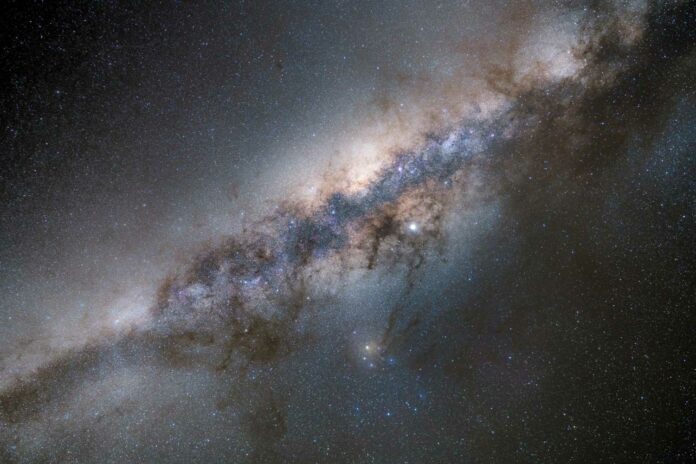The Milky Way spins like water in a whirlpool because of the matter in its disk. In the 1970s, Vera Rubin noticed galaxies, including ours, have surprisingly flat rotation curves. This means the speed of stars stays the same across the universe instead of slowing down with distance. Rubin suggested that invisible dark matter is at play, influencing star motion.
Her work supported the idea of dark matter, an unseen force outweighing visible matter in the universe. Scientists are now studying the Milky Way’s rotation curve with stars to understand dark matter within our galaxy.
MIT physicists studied how fast stars move in the Milky Way galaxy. They found that stars farther from the galaxy’s center move more slowly than expected. This surprising result suggests that the Milky Way’s core, where most of its mass is located, might be lighter and contain less dark matter than scientists previously thought.
The researchers used data from Gaia, a space telescope tracking stars, and APOGEE, a ground-based survey. They analyzed measurements of over 33,000 leads to determine each star’s “circular velocity,” or how fast it moves in the galaxy. They created a rotation curve by plotting this velocity against the distance from the galaxy’s center. This curve helps scientists understand visible and dark matter distribution in a galaxy.
Lina Necib, assistant professor of physics at MIT, said, “What we were amazed to see was that this curve remained flat, flat, flat out to a certain distance, and then it started tanking. This means the outer stars are rotating slightly slower than expected, which is a surprising result.”
The scientists used the new rotation curve data to create a map of the distribution of dark matter that could account for the slower movement of outer stars. Surprisingly, the map suggested that the core of the Milky Way may be less dense and contain less dark matter than previously believed by scientists. In simpler terms, the central part of our galaxy might be lighter than we thought, with less invisible dark matter.
Necib said, “This puts this result in tension with other measurements. There is something fishy going on somewhere, and it’s fascinating to figure out where that is, to have a coherent picture of the Milky Way.”
Frebel, Necib, Ou, and Eilers utilized the new data from Gaia and APOGEE to expand on the initial rotation curve. They refined their analysis by combining Gaia’s measurements with APOGEE’s detailed data on over 700,000 stars, capturing properties like brightness, temperature, and elemental composition.
The team used an algorithm to connect these diverse data points and improve estimates of star distances, enabling them to study stars at greater distances. With precise distance measurements for over 33,000 stars, they created a three-dimensional map of stars across the Milky Way up to 30 kiloparsecs. This map was integrated into a circular velocity model, simulating the speed of each lead based on the distribution of all stars in the galaxy. The resulting chart provided an updated rotation curve for the Milky Way, showcasing the velocity and distance of each star.
Necib says, “That’s where the weirdness came in.”
In contrast to previous rotation curves showing a gentle decline, the team noticed a more pronounced dip at the outer edge in the new curve. This unexpected downturn implies that, while stars maintain their speed up to a certain distance, they unexpectedly decelerate at greater distances. Stars on the outskirts of the galaxy move more slowly than anticipated.
Translating this rotation curve into the amount of dark matter distributed in the galaxy, the researchers concluded that the core of the Milky Way likely contains less dark matter than previously thought. In simpler terms, the central part of our galaxy may have less invisible dark matter than scientists initially estimated.
Necib says, “This result is in tension with other measurements. Understanding this result will have deep repercussions. This might lead to more hidden masses just beyond the edge of the galactic disk or a reconsideration of the state of equilibrium of our galaxy. We seek to find these answers in upcoming work, using high-resolution simulations of Milky Way-like galaxies.”
Journal Reference:
- Xiaowei Ou, Anna-Christina Eilers et al. The dark matter profile of the Milky Way inferred from its circular velocity curve. Monthly Notices of the Royal Astronomical Society. DOI: 10.1093/mnras/stae034
